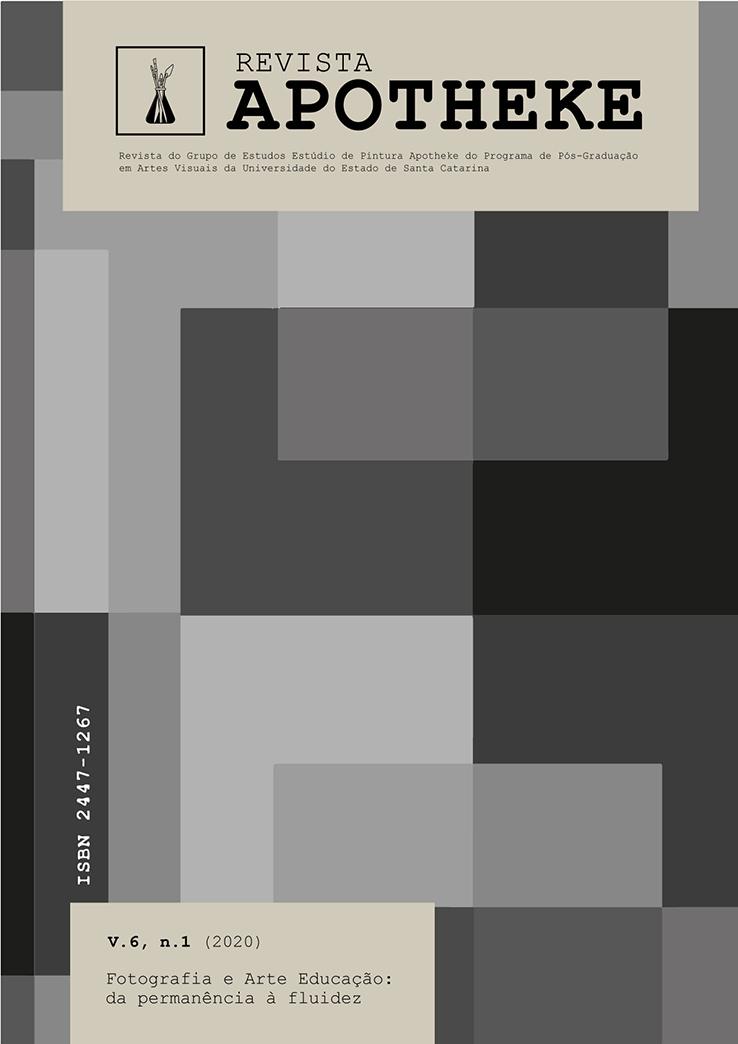A fotografia e o sentir: não vidência e outros sentidos.
DOI:
https://doi.org/10.5965/24471267612020093Palabras clave:
Fotografia, Percepção tátil, Paisagem Sonora, Deficiência Visual; Inclusão.Resumen
O Projeto A Fotografia e o Sentir compreende o ensino e a prática fotográfica junto aos alunos do IEACN - Instituto de Educação e Assistência aos Cegos do Nordeste, localizado na cidade de Campina Grande - PB. Sua realização encontra-se ancorada na oportunidade de ampliar as pesquisas sobre acessibilidade e inclusão, bem como desenvolver recursos didáticos e metodológicos ao difundir a fotografia para pessoas com deficiência visual. Deste modo, este estudo abarca de maneira não exaustiva o uso da multissensorialidade para a construção imagética, ao explorar estímulos auditivos e táteis na produção, leitura e recepção de fotografias. O texto propõe um debate sobre as contribuições da percepção e do sentir para o processo de aprendizagem e a importância de oportunizar ao aluno não vidente o papel de fonte emissora e criativa. O percurso teórico envolveu Vygotsky (1997), Schafer (2003), Duarte Júnior (2012), Alves (2009) entre outros.
Descargas
Citas
ALVES, Jefferson Fernandes. Deficiência visual e fotografia: O olhar pelo som, pelo tato e pela palavra alheia. In: V Congresso Brasileiro Multidisciplinar de Educação Especial. Londrina, 2009.
_______. O olhar pelo tato e pela voz: não vidência, fotografia e prática docente. In: Revista Educação em Questão, Natal, v. 27, n. 13, set./dez. 2006.
BAVCAR, Evgen. A Luz e o Cego. In: BAVCAR, Evgen. O ponto zero da fotografia. VSA art do Brasil, 2000. Disponivel em: <https://dobrasvisuais.files.wordpress.com/2010/08/a-luz-e-o-cego.pdf>. Acesso: 18.jan.2020.
D´AVILA, Renato. Teco Barbero revela mistérios da fotografia cega. In: Novo Olhar, G1-Sergipe, 2017. Disponível em: <http://g1.globo.com/se/sergipe/blog/novo-olhar/post/teco-barbero-revela-misterios-da-fotografia-cega.html>. Acesso em: 10. dez. 2019.
DONDIS, A. Donis. Sintaxe da Linguagem Visual. trad. Jefferson Luiz Camargo. São Paulo: Martins Fontes, 2007.
DUARTE JUNIOR, João Francisco. Por que arte-educação? 6 ed. Campinas - Sp: Papirus, 2012.
FOULKES, Benjamin Mayer. Más allá de la mirada. (entrevista com Evgen Bavcar).
Disponível em . Acesso em: 10. dez. 2019.
CANCLINI, Nestor GARCIA. Culturas híbridas. São Paulo: Edusp, 2000.
MAIA, João. Conheça João Maia, o fotógrafo cego, 2017. Disponível em: <https://college.canon.com.br/blog/conheca-joao-maia-o-fotografo-cego-56>. Acesso em: 10. dez. 2019.
MERLEAU-PONTY, MAURICE. Fenomenologia da Percepção. São Paulo: Martins Fontes, 1994.
MORICEAU, Jean-Luc; PAES, Isabela. Performances acadêmicas e experiência estética: Um lugar ao sensível na construção do sentido. In: PICADO, Benjamin (Org); et.al. Experiência Estética e Performance. Salvador: Edufba, 2014.
NUNES, Sylvia; LOMÔNACO, José Fernando Bitencourt. O aluno cego: Preconceitos e potencialidade. In: Revista Semestral da Associação Brasileira de Psicologia Escolar e Educacional, SP. v. 14, n. 1, Jan/Jun, 2010.
OLIVEIRA, João Ganzarolli. Do essencial invisível: Arte e Beleza entre os Cegos. Rio de Janeiro: Revan Faperj, 2002.
População residente por tipo de deficiência permanente. IBGE, 2010. Disponível em: https://www.ibge.gov.br/estatisticas/sociais/populacao/9662-censo-demografico-2010.html?edicao=9749&t=destaques. Acesso em: 18. jan. 2010.
RODRIGUEZ, Ángel. A dimensão sonora da linguagem audiovisual. São Paulo: SENAC São Paulo, 2006.
SCHAEFFER, Pierre. Ensaio sobre o Rádio e o Cinema: Estética e Técnica das Artes-relé 1941-1942. Belo Horizonte: UFMG, 2010.
SCHAFER, R. Murray. O ouvido pensante. São Paulo: UNESP, 2003.
TEIXEIRA, Carolina. A cultura da acessibilidade: Desafios à produção artística brasileira. In: Revista do Centro de Pesquisa e Formação SESC SP. n 06, Jun, 2018.
VILLAÇA, Iara. Arte-educação: a arte como metodologia educativa. In: Revista Cairu. Salvador, ano 03, n 04, Jul/Ago, 2014.
VYGOTSKI, Lev. S. Fundamientos da Defctologia: Obras Escogidas V. Madri: Visor, 1997.
Referências Filmográficas
JANELA da Alma. Direção de João Jardim e Walter Carvalho. São Paulo: Dueto Filmes, 2001 (73 min.).
Descargas
Publicado
Cómo citar
Número
Sección
Licencia
Derechos de autor 2020 REVISTA APOTHEKE

Esta obra está bajo una licencia internacional Creative Commons Atribución-NoComercial 4.0.
Política de Derechos de Autor y Licenciamiento
Los autores de los trabajos enviados a la Revista APOTHEKE autorizan su publicación en formato impreso y digital, exclusivamente con fines académicos, pudiendo ser reproducidos siempre que se cite correctamente la fuente. Los autores certifican la originalidad, autoría y carácter inédito de sus manuscritos.
Los artículos publicados por la revista están disponibles gratuitamente y destinados a fines académicos y no comerciales. Todos los derechos de autor son cedidos a la revista. Los artículos firmados representan exclusivamente la opinión de sus autores y no reflejan la posición oficial de la Revista Apotheke. Los autores se comprometen a citar la publicación original siempre que reproduzcan, divulguem o hagan referencia al artigo publicado en la Revista Apotheke, de la siguiente forma:
“Este artículo fue publicado originalmente por la Revista Apotheke en el volumen (colocar el volumen), número (colocar el número), en el año (colocar el año), y puede ser consultado en: http://www.revistas.udesc.br/index.php/APOTHEKE/index”
Es responsabilidad exclusiva de los autores obtener autorización por escrito para el uso de cualquier material protegido por derechos de autor incluido en sus artículos. La Revista Apotheke no se responsabiliza por eventuales infracciones cometidas por sus colaboradores.
Los autores conservan los derechos de autor y conceden a la revista el derecho de primera publicación, bajo la licencia Creative Commons de tipo Atribución-NoComercial (CC BY-NC):
-
Atribución (BY): Los licenciados pueden copiar, distribuir, mostrar, ejecutar y crear obras derivadas, siempre que se otorgue el crédito correspondiente al autor o titular de la licencia, en la forma indicada.
-
Uso No Comercial (NC): Los licenciados pueden usar el material solo con fines no comerciales.
Después de la publicación, los autores conservan sus derechos de autor y pueden volver a publicar el texto.



